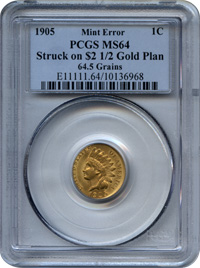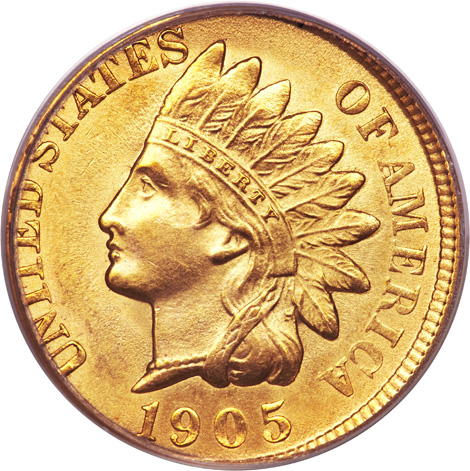
 From The Heritage Auction Listing:
From The Heritage Auction Listing:
Exactly five Indian cents are known on gold planchets, according to information available to us. Among them are three dated 1900, this piece dated 1905, and an example dated 1906. The Judd pattern reference lists 1900 and 1907 gold cents in the section on mint errors. However, Andrew W. Pollock, III, listed the 1900 gold Indian cents as P-1990 in the regular pattern section of his reference. Pollock writes: “Listed in Judd as a mint error, but it is difficult to imagine that a Mint employee would be so careless as to feed gold planchets into a coinage press fitted with one-cent piece dies.” Pollock suggests that these pieces may have been deliberately struck for one or more collectors.
The following Census of gold Indian cents and additional information about them is compiled from a variety of sources, including uspatterns.com, minterrornews.com, Donald Taxay’s 1976 Catalogue and Encyclopedia, Andrew Pollock’s 1994 United States Patterns and Related Issues, the Judd reference, and selected auction catalogs. Conversations with Fred Weinberg and Richard Snow provided additional background.
1900 MS65 PCGS. Col. E.H.R. Green; B.G. Johnson; Abner Kreisberg Corporation 1/1975 auction, lot 609; Mike Byers; Auction ‘89 (Superior, 7/1989), lot 856; Bowers and Merena (8/1991), lot 4103; recently PCGS authenticated as a 1900 Indian cent struck on a gold $2.50 planchet, and graded MS65. The 1991 ANA catalog gives a weight of 65.8 grains, 1.3 grains too much for a quarter eagle planchet.
1900 AU55. Heritage (8/1993), lot 8000. The 1993 ANA catalog gives a weight of 4.35 grams (67.12 grains), 2.62 grains too much for a quarter eagle planchet.
1900. Michael Hodder reported in a May 14, 1996 letter to Q. David Bowers that he had personally seen three different pieces, all with weights in the range of 65.8 to 67.1 grains. See Bowers’ A Buyer’s and Enthusiast’s Guide to Flying Eagle and Indian Cents, p. 427.
1905 MS64 PCGS. Apparently unknown to the numismatic community prior to the current offering. Weight: 64.5 grains, the standard weight for a quarter eagle planchet.
1906 AU58 NGC. Stack’s (6/2004), lot 4097; Stack’s (9/2009), lot 4299. Weight: 64.4 grains, within the 0.25 grain tolerance for a quarter eagle planchet.
1907. Listed in the Judd pattern book, and in Donald Taxay’s Catalogue and Encyclopedia [of] U.S. Coins. The 1907 gold Indian cent is currently unlocated.
One example dated 1900 is also known in silver, from the identical dies as the 1900 gold Indian cents, suggesting they were all made at or near the same time. Rick Snow writes in A Guide Book of Flying Eagle and Indian Head Cents that “both the silver and gold examples are struck from the same dies, with light roughness on the reverse die, probably from die rust.” That all three 1900 pieces have higher weights suggests that they were specially made, perhaps without the knowledge of Mint officials. Fred Weinberg explained to this cataloger that “the weights vary because in all probability, they were on planchets that might not have been filed down to the proper weight spread.” Hand adjusting of individual gold planchets continued in the Mint until circa 1910. Those three pieces are almost certainly fancy pieces made for collectors, while the 1905 and 1906 examples, on correct weight planchets, are more likely pieces truly made in error, and substantially more important as such.
This example is slightly off-center toward 9 o’clock, the tops of UNITED STATES off the planchet. The strike is weak at the date, feather tips, RICA, the outer parts of the wreath, and the ribbon bow. The weakness seems counter to expectations of the soft gold, but the diameter is at least a full millimeter less than an Indian cent, meaning that the metal flowed out and was insufficient to accept the design from the deepest recesses of the dies. Both sides have fully brilliant yellow surfaces with frosty mint luster. A few faint hairlines on the cheek prevent a Gem grade assignment. This stunning gold Indian cent is one of the truly amazing error coins we have ever handled.



